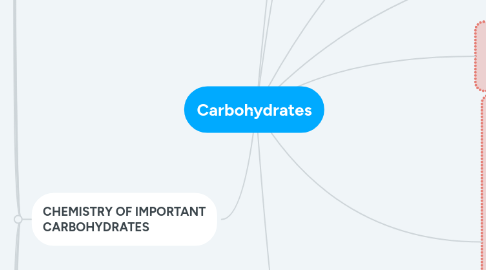
1. CHEMISTRY OF IMPORTANT CARBOHYDRATES
1.1. Maltose
1.1.1. Disaccharides
1.1.2. Present in Germinating Grain
1.1.3. Forms on partial hydrolysis of Starch
1.1.4. Reducing Sugar
1.1.5. Malting
1.2. Lactose
1.2.1. Milk Sugar
1.2.2. Occur in Milk of Mammals
1.2.3. By product in manufacturing of Cheese
1.2.4. Reducing Sugar
1.2.5. Disaccharide
1.2.6. Lactose Intolerance
1.3. Sucrose
1.3.1. Table Sugar
1.3.2. Most abundant
1.3.3. Obtained from Sugarcane and Sugar beets
1.3.4. Occurs in Sorghum, Sugar maple and Pineapple juice
1.3.5. Disaccharides
1.3.6. Sugar Processing
1.4. Starch
1.4.1. Polymer of Glucose
1.4.2. Found in Roots, Rhizomes, Tubers, Seeds and Corms of plant
1.4.3. Structural Units
1.4.3.1. Amylose
1.4.3.1.1. 20-30% Water soluble material
1.4.3.2. Amylopectin
1.4.3.2.1. Much higher molecular weight
1.4.4. Chemical Modifications
1.4.4.1. Cross Linking
1.4.4.2. Substitution
1.4.4.3. Hydrolytic Cleavage
1.4.4.4. Hydrolysis
1.4.5. Uses
1.4.5.1. Versatile and Cheap
1.4.5.2. AMYLOSE
1.4.5.2.1. Used as Hydrocolloid it forms useful gels and films
1.5. Thickener, Water binder, emulsion Stabilizer, gelling agent
1.6. Gums And Seaweeds
1.6.1. Xanthum Gum
1.6.1.1. Microbial desiccation resistant polymer
1.6.1.2. Commercially prepared from aerobic fermentation from Xanthomonas Campestris
1.6.1.3. Anionic polysaccharides
1.6.1.4. Stable upto 100 degrees
1.6.1.5. APPLICATIONS
1.6.1.5.1. Thickener for sauces
1.6.1.5.2. To prevent ice crystal formation in ice creams, etc.
1.6.2. Carrageenan
1.6.2.1. Collective term used for polysaccharides
1.6.2.2. Prepared by alkaline extraction from red seaweeds
1.6.2.3. commercially important hydrophylic coloids
1.6.2.4. Occurs as matrix materials
1.6.2.5. Serves as structural function similar to cellulose
1.6.2.6. Chemically Sulphated Glycars
1.6.2.7. Linear polysaccharides
1.6.3. Agar and Agarrose
1.6.3.1. Natural polysaccharide isolated from red seaweeds
1.6.3.2. Components of agar extract
1.6.3.2.1. Agarose
1.6.3.2.2. Agaropectin
1.6.3.2.3. Agar contains 50-90% of agar rose
1.6.3.2.4. Agar rose is a natural polysaccharide
1.6.3.2.5. Agar gels are transparent, thermoreversible
1.7. Pectin
1.7.1. Polysaccharide
1.7.2. Act as a cementing material in walls of plant cells
1.7.3. Made from apple pomace and citrus fruit pulp
1.7.4. 300-1000 galacturonic acid units
1.7.5. Classification
1.7.5.1. High Methoxy Pectin
1.7.5.1.1. DE> 50%
1.7.5.2. Low Methoxy Pectin
1.7.5.2.1. DE< 50%
1.7.5.2.2. make suitable gels at 0.5 - 1.5 %
1.7.6. Food Applications
1.7.6.1. Jams and Jellies
1.7.6.2. Fruit prep. for Yoghurt
1.7.6.3. Food drinks concentrates
1.7.6.4. Confectionary Products
1.7.6.5. Fruit Juice
1.7.6.6. Fruit/ milk desserts,fermented and directly acidified milk products and gelled milk products
1.8. Glucose
1.8.1. Monosaccharide
1.8.2. Aldohexose
1.8.3. Reducing Sugar
1.8.4. Primary Carbon utilised by body tissue
1.8.5. Other Carbohydrates are converted to glucose before use
1.9. Dextrans
1.9.1. Forms from fermentation of Leuconastoc Mesenteroides
1.9.2. Polysaccharides
1.9.3. Similar to amylopectin
1.9.4. Oral bacterial product adheres to the teeth called plaque
1.9.5. Commercially used as confectins, as food additives and plasma volume expanders
1.9.6. Used in Medicine as extenders in treatment of shock
1.10. Cellulose
1.10.1. More than 50% of total organic Carbon in Earth's biosphere is cellulose
1.10.2. Cotton Fibers are pure Cellulose
1.10.3. Wood of bushes and trees contains 50% of cellulose
1.10.4. Polymer of Glucose
1.10.5. Synthetic modifications of cellulose
1.10.5.1. Cellulose Acetate
1.10.5.1.1. Prepared by treating cotton with acetic acid (Sulphuric Acid is a catalyst)
1.10.5.1.2. Properties
1.10.5.1.3. Applications
1.10.5.2. Hemicellulose
1.10.5.2.1. Present together with other natural polusaccharide like cellulose, lignins and pectins in cell walls of plants
1.10.5.2.2. Compounds which are extractable by aqueous alkali after delignification
1.10.5.2.3. Composed of 50-100 units
1.10.5.2.4. Heteropolysaccharides
1.10.5.2.5. XYLOSE
1.10.5.2.6. MANNANS
1.10.5.2.7. GLUCOMANNANS
2. DEFINITION
2.1. Polyhydroxy aldehydes and ketones
3. TYPES
3.1. Simple Sugars
3.2. Complex Carbohydrates
4. SACCHARIDES
4.1. Greek Word "Sakchron''
5. ABSORPTION OF SUGARS
5.1. Sugars & Starches
5.2. Conversion Process
5.2.1. Simple Diffusion
5.2.2. Facilitated Diffusion
5.2.3. Active Transport
5.3. Constituent Monosaccharides
5.3.1. Glucose from Starch, Oligosaccharides- Maltose, Lactose & Sucrose
5.3.2. Fructose from Sucrose
5.3.3. Galactose from Lactose
6. EFFECT OF SUGAR ON HEALTH
6.1. Blood Glucose Level
6.1.1. Glycaemic Response
6.1.1.1. Glycaemic Index
6.1.2. Factors affecting Blood Glucose Level
6.1.2.1. Amount of food consumed at one sitting
6.1.2.2. Energy content and composition of habitual diet
6.1.2.3. Method of Blood Sugar analysis & site of Blood sampling
6.1.2.4. Presence of other food constituents
6.1.2.5. Raw, Cooked, Processed Food
6.1.2.6. Time period after which response is measured
6.2. Other metabolic diseases
6.2.1. Diabetes
6.2.2. Obesity
6.2.3. Hypoglycemia
6.2.4. Dental Problems

